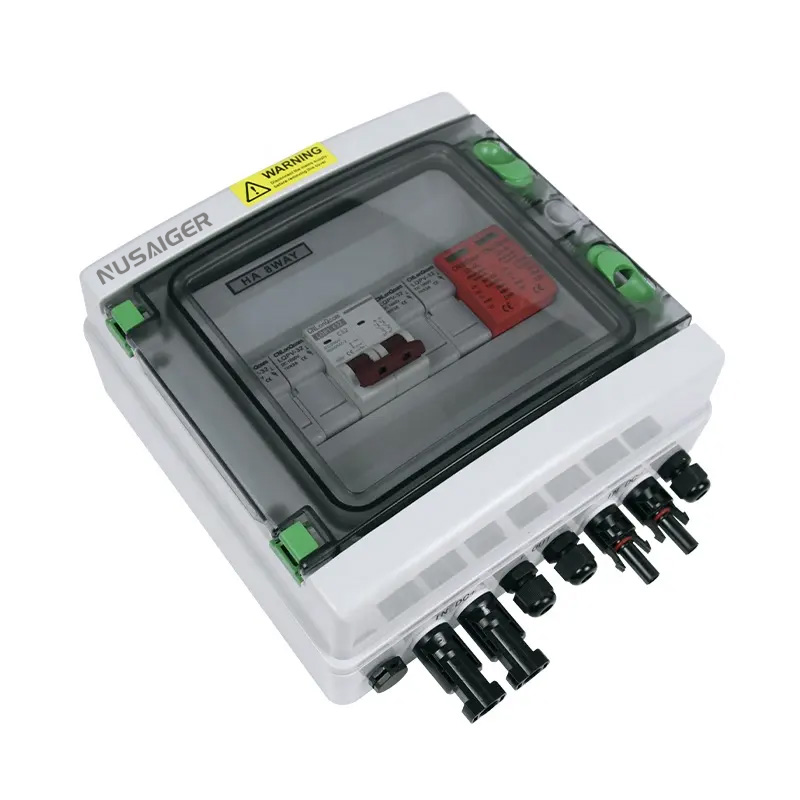Maintenance Best Practices for PV Combiner Boxes
A practical guide to ensure long-term performance, safety, and reliability of solar combiner boxes.
1. Introduction
PV combiner boxes are critical for consolidating DC power, protecting circuits, and enabling monitoring.
Like all electrical components, they require regular maintenance to prevent failures, extend service life,
and ensure uninterrupted solar plant operation.
This article outlines the best practices for preventive and corrective maintenance of PV combiner boxes,
with actionable steps for O&M teams.
2. Why Maintenance Matters
- Prevents unplanned outages and energy loss.
- Identifies hidden issues before they escalate.
- Ensures compliance with safety standards and warranties.
- Reduces long-term replacement costs.
3. Routine Inspection Checklist
Inspections should be conducted quarterly or bi-annually depending on plant size and environment.
- Visual inspection of enclosure for cracks, rust, or water ingress.
- Check seals, gaskets, and cable glands for integrity.
- Ensure labels and safety warnings remain visible.
- Inspect for signs of overheating, such as discoloration.
- Verify torque settings of electrical connections.
4. Thermal Imaging and Hot Spot Detection
Infrared thermography helps detect loose connections or overloaded circuits.
Hot spots indicate resistive heating that could lead to equipment damage.
- Perform thermal scans during peak sunlight hours.
- Compare readings across all string connections.
- Investigate anomalies exceeding 10–15°C above baseline.
5. Moisture and Environmental Protection
Moisture ingress is one of the most common causes of failure in outdoor combiner boxes.
Preventive measures include:
- Inspect IP65/IP66 seals regularly.
- Replace damaged gaskets immediately.
- Install breather valves or anti-condensation heaters in humid environments.
- Apply corrosion inhibitors to busbars and terminals.
6. Fuse and Circuit Breaker Maintenance
Fuses and breakers are frontline protection devices and must be checked periodically.
- Replace blown fuses with identical ratings.
- Check fuse holders for burn marks or melting.
- Exercise circuit breakers to prevent mechanical jamming.
- Keep spare fuses and breaker modules in inventory.
7. Surge Protection Device (SPD) Replacement
SPDs degrade over time after multiple surge events.
Failure to replace them leaves the system exposed to lightning or grid surges.
- Check SPD indicator windows (green = active, red = expired).
- Replace expired SPD modules immediately.
- Verify grounding connections for surge dissipation.
- Document replacement dates for asset tracking.
8. Wiring and Connection Integrity
Loose or corroded connections cause overheating and energy loss.
- Tighten connections to manufacturer torque specifications.
- Use infrared scans to verify no hidden hotspots.
- Inspect for cable insulation cracks or UV degradation.
- Replace damaged connectors with weatherproof types.
9. Remote Monitoring and Data Analysis
Smart combiner boxes enable remote fault detection and reduce manual inspection frequency.
- Monitor string currents for imbalance detection.
- Receive SPD and breaker status alerts.
- Integrate with SCADA or cloud platforms for trend analysis.
- Use data analytics to predict failures before they occur.
10. Preventive Maintenance Schedule
| Task | Frequency |
|---|---|
| Visual inspection | Quarterly |
| Torque check on terminals | Semi-annually |
| Thermal imaging scan | Bi-annually |
| SPD replacement (if triggered) | As needed |
| Fuse replacement | As needed |
| Enclosure sealing check | Annually |
11. Safety Precautions During Maintenance
- Always de-energize circuits before inspection.
- Use insulated tools and wear PPE.
- Follow lockout/tagout (LOTO) procedures.
- Keep maintenance logs for safety audits.
12. Case Studies
Solar Farm in South Africa
Implemented quarterly thermography inspections.
Result: Identified loose connections early, reducing downtime by 25%.
Coastal Rooftop in Philippines
Added anti-condensation heaters.
Result: Eliminated corrosion failures caused by humidity.
Utility Plant in USA
Integrated smart combiner monitoring with SCADA.
Result: Reduced manual inspection trips by 40%, saving O&M costs.
13. Conclusion
Preventive and proactive maintenance of PV combiner boxes ensures system safety, improves reliability,
and minimizes energy loss.
By following structured inspection routines, leveraging thermal imaging, replacing critical components on time,
and integrating smart monitoring, O&M teams can significantly enhance the performance and lifespan of solar assets.



